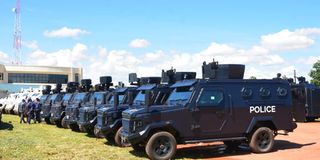Uganda police carry out drills in anticipation of food prices city protests

Uganda Police recently acquired new and improved classified equipment to be used in dealing with civil disobedience in the country and also help in their missions in Somalia.
Uganda Police Force have carried out drills in anticipation of Kenya-like protests in urban areas due to the rising cost of living.
Police’s directorates, like Field Force Unit and Counter Terrorism Directorate, held joint drills at a training facility in Kigo, Wakiso District, yesterday where they both displayed their capabilities to deal with terror attacks and protests at the same time.
The Deputy Inspector General of Police, Maj Gen Geoffrey Katsigazi, personally witnessed the drills.
Police spokesperson Fred Enanga yesterday told Daily Monitor that several groups, including those from the opposition, are holding secret meetings with the intention of rallying their members to carry out street protests.
“Our joint security teams have got intelligence that groups are holding meetings to protest against the rising prices of commodities like it is the case in Kenya,” Mr Enanga said.
In several African countries, including Kenya, people are rising up to protest the high cost of living and democracy. Similar uprisings due to food prices in 2011 led to the toppling of African leaders in Egypt, Tunisia and Libya.
In Uganda, the protests code-named Walk-to-Work led by Mr Mathias Mpuuga, now the leader of the Opposition in Parliament, and Dr Kizza Besigye lasted for five years and left more than a dozen people killed and hundreds injured.
Mr Enanga said they will deal firmly with any uprising.
“There are many sections of the Public Order Management Act that are still in place, including notifying the Inspector General of Police about the planned demonstrations. Organisers of demonstrations should follow the law,” he said.
At Kigo drill, the joint police team re-enacted an incident that happened during the recent general elections where police arrested National Unity Platform leader Robert Kyagulanyi, alias Bobi Wine in Luuka District leading to protests in which security personnel killed 54 people and arrested hundreds others.
During the drills, the Counter Terrorism team raided a place where terrorists were keeping a kidnapped leader. After hearing loud bangs, some members of the public misinformed others on social media that their political leader had been killed by the government security personnel.
The supporters of the politician then converged near the scene to establish what had happened to their leader. Police officers talked to them but failed to convince them. It was at that time that the first anti-riot police with shields turned up, but the members of the public became rowdy and threw stones at them. The protestors quickly overwhelm the anti-riot police holding shields.
At that time, motorised anti-riot police are called in and use Riot Control Vehicles to teargas the protestors, who are defeated instantly. They handed over the scene to riot police on foot to clear the debris from the road, but an armed protesters fired at the police officers.
The police respond by deploying a Counter Terrorism team that uses bullets to confront the armed protester and then kill him.
Kampala Metropolitan Police spokesperson Patrick Onyango said the drill was intended to show how to handle incidents that evolve fast from use of teargas to live bullets.
Since the November 2020 protests, the Uganda government has invested billions of shillings in the procurement of equipment to deal with civil disobedience.
Police bought 65 trucks, including 15 Riot Control Vehicles this month. Some of the trucks use laser beams to target suspect riots. The laser causes serious headaches.





